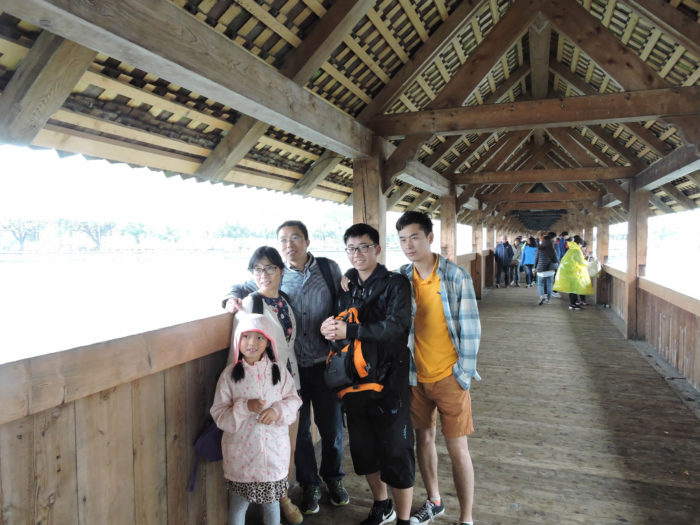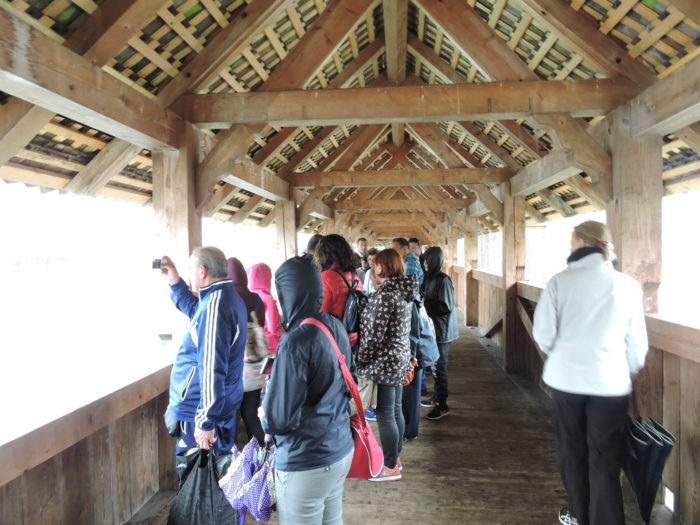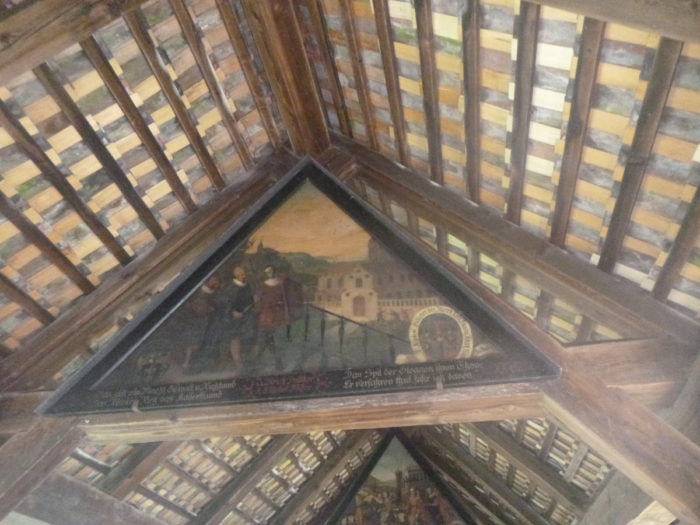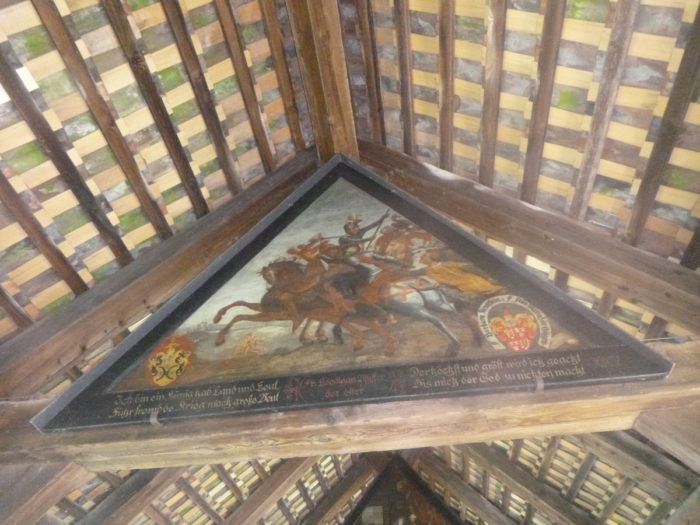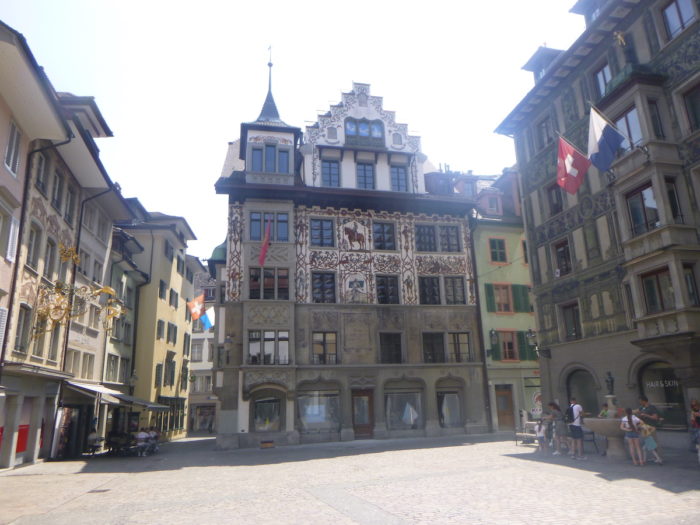A quick visit to Luzern
|
If you happen to arrive here on a rainy day, the scene that unfolds before your eyes carries an almost palpable melancholy. It’s as if you’re stepping into a city set in the background, with a vast warehouse to your left and a few church spires rising above the rooftops. But let’s not skimp on compliments. Luzern is a city of exquisite beauty. On a clear day, it transforms completely.
|
 |
 |
| The advantage of exploring a highly touristy city in the rain is undeniable. It’s much easier to navigate a city where tourists have significantly extended their breakfast before rushing off to buy watches and knives. In the rain, there’s not much of a crowd at the harbor. Umbrellas and raincoats are out in force. But today, we will visit the city under magnificent weather conditions. |
 |
 |
To help you navigate, here is a city map (https://www.orangesmile.com/common/img_city_maps/lucerne-map-0.jpg).

Let’s begin our exploration at the Bahnhof Platz (Train Station Square).

| Near the harbor stands Luzern’s terminus station. Luzern’s first railway station was established at the end of the 19th century. Its proximity to the lake and its prime location in the heart of the city contributed to its success, as did the beginning of steamboat operations on the lake. It has become an important railway hub, with departures to the Gotthard and also to the Bernese Oberland, attracting crowds of Asians, Indians, or Arabs traveling in masses to Interlaken on the single-track train that passes through the Brünig. |
 |
 |
| The station suffered a serious fire in 1971. A temporary station was erected, and plans for a new station emerged. The new station was designed by Santiago Calatrava Valls, a Spanish architect known for designing numerous bridges and stations. But the station is not merely a transit point; it’s also a massive commercial complex. |
 |
 |
| It is also here, near the station, close to the boat boarding docks, that the renowned architect Jean Nouvel signed the prestigious KKL in 1998, which from a distance resembles an imposing metal hangar. This is the Culture and Convention Center (KKL), a building that cost a whopping 226 million Swiss francs. The architect integrated water into the architecture, unable to build the structure on water as he had wished. Water is omnipresent, both inside and out. |
 |
 |
| The building houses a concert hall, a multifunctional hall, the Luzern Art Museum, as well as other spaces dedicated to conferences and conventions, not to mention restaurants. |
 |
 |
| The concert hall, accommodating up to 1900 seated spectators, is renowned for its exceptional acoustics. It hosts a wide variety of musical genres but remains primarily dedicated to classical music. The Luzern Festival, organized since 1938 in August and September, is now a major event in symphonic music, offering more than 30 concerts with the world’s most prestigious orchestras. Since 1999, the summer festival has chosen a specific theme. In fact, we should speak in the plural of festivals because two other events punctuate the year: the Easter Festival, focused on baroque music, and the Piano Festival in November. |
 |
 |
| The Luzern Art Museum, located on the top floor of the KKL, presents temporary exhibitions covering various currents of contemporary art as well as collections dedicated to Swiss art, from the Renaissance to the present day. Some may prefer the Picasso Museum, which has a remarkable peculiarity: there are no paintings by the master. Visitors will find lithographs, engravings, ceramics, and portraits there. And of course, there’s the Transport Museum, located at the entrance of the city, on the other side of the lake. |
 |
 |
In front of the KKL, a modest and uncertain portico welcomes visitors to Luzern.

Now, let’s go up the Reuss to discover the two magnificent wooden bridges of Luzern.

| While watches captivate Asian tourists, Luzern possesses an invaluable treasure that attracts visitors from around the world: Europe’s oldest covered wooden bridge, more photographed even than the Matterhorn. This is the famous Chapel Bridge (Kappelbrücke), erected in 1333, nearly 700 years ago, to connect the two banks of the city spanning the Reuss. Once longer, part of the bridge was swept away by floods, leaving only its current 204 meters. |
 |
 |
| In the middle of the bridge stands the Water Tower (Wasserturm), erected at the beginning of the 14th century. This octagonal tower, 34 meters high, formerly served as a prison and housed the city archives. Today, it houses the headquarters of the Luzern Artillery Association. |
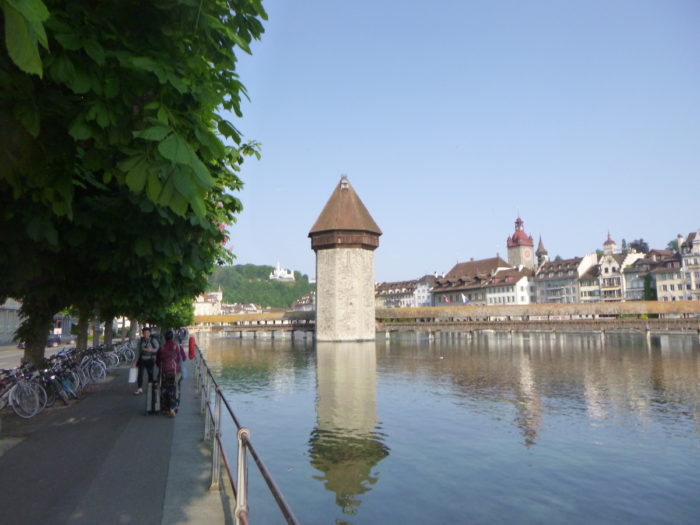 |
 |
| The atmosphere on the bridge depends on the time of day. To enjoy the tranquility, it’s better to come before the influx of tourists. |
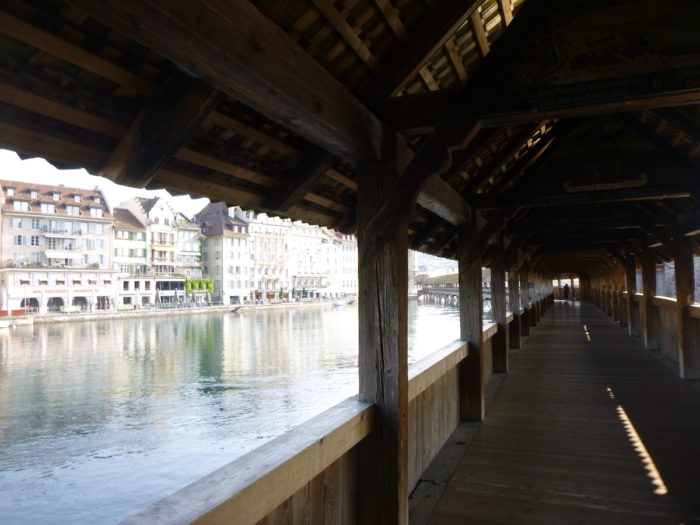 |
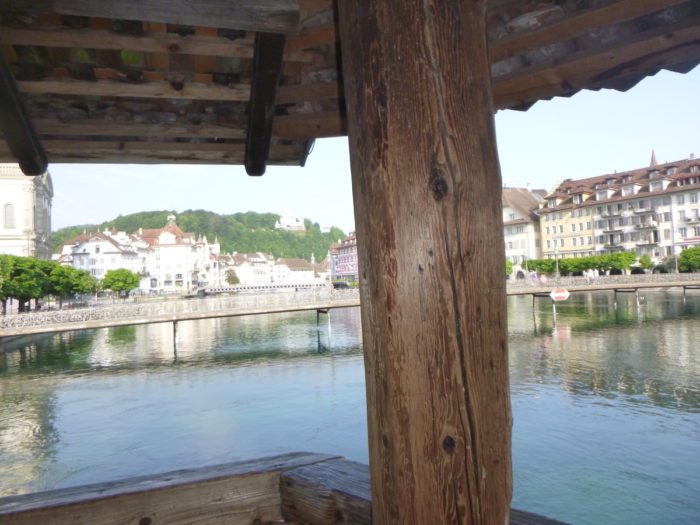 |
| In rainy weather, the atmosphere on the bridge is less enchanting, but that doesn’t stop visitors from flocking. Sometimes there are even traffic jams. Between souvenir shops, visitors from Alsace also hurry for a group photo. |
 |
 |
| Triangular oil-painted panels from the 17th century are present under the bridge’s framework. These paintings, glorifying the city’s importance, depict the main events of Swiss history. It’s known that there were supposed to be 150 units. Unfortunately, on the night of August 17-18, 1993, the bridge got very hot. A violent fire, of unknown origin, ravaged the wooden structure, which immediately caught fire, leaving only the two ends of the bridge intact. A major catastrophe, of course. In 8 months, a bridge was rebuilt identically, or almost. As for the paintings, a certain number of them could be restored from old illustrations. But most of them turned to ashes, as evidenced by the empty spaces left under the framework. |
 |
 |
| At the end of the Kappelbrücke, on the same riverbank, you find the former Jesuit Church, one of Switzerland’s great Baroque churches. Dating from the 17th century, it is dedicated to St. Francis Xavier, a Jesuit missionary. Part of a complex that formed the Jesuit College, it has undergone some amendments since. |
 |
 |
| Going up the Reuss, there are metal footbridges that allow crossing the river. Up on the hill stands the Gütsch Castle. |
 |
 |
| From the second metal footbridge, you are in front of the Spreuerbrücke. |
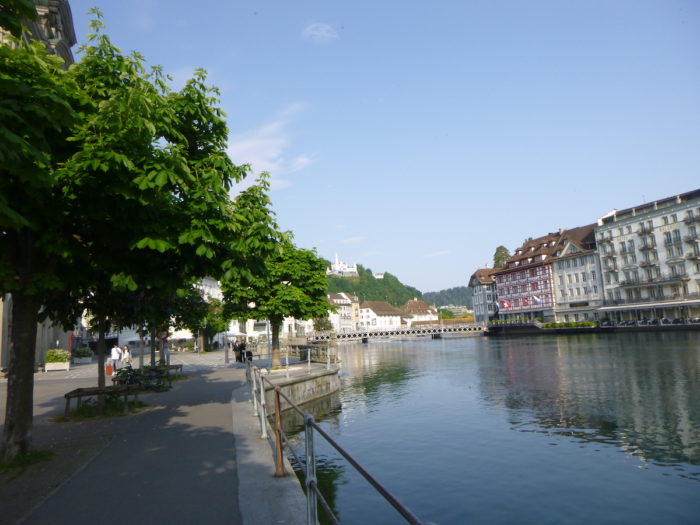 |
 |
| Luzern has another famous wooden bridge: the « Dance of Death Bridge » (Spreuerbrücke). This one, also made of wood, is just as beautiful as the Kappelbrücke, albeit a bit darker. Here, the bridge did not catch fire. It dates back to 1408, its function being to protect the city against invasions. The bridge gets its name from the German word Spreu, meaning chaff. This was the place from which cereal straw and dead leaves could be thrown into the river. The Luzern painter Kaspar Meglinger painted here, in the 17th century, 67 panels on the theme of the Dance of Death. |
 |
 |
| From the bridge, you have beautiful views of the river towards the Jesuit Church. |
 |
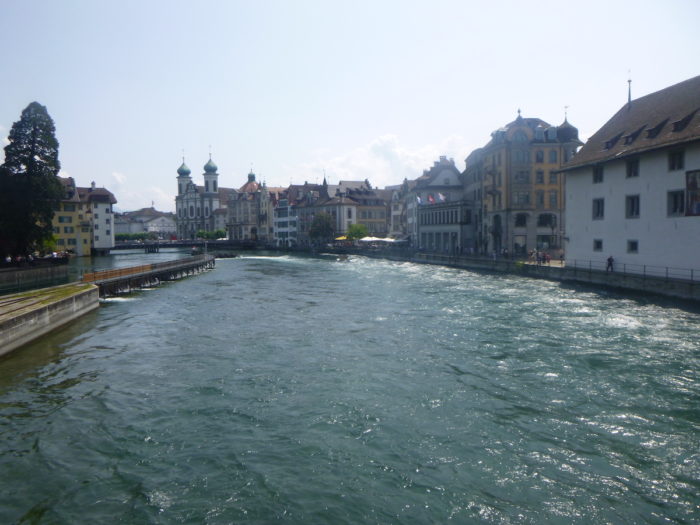 |
| Most tourists don’t go further than the Speuerbrücke. But if you continue up the Reuss, you can go up to the Gütsch Castle, on foot or by funicular. In 1859, Burkhard Pfyffer bought a plot of land on the Gütsch hill from the city and obtained the right to run an inn. The inn was later expanded into a hotel. The Castle was built in 1884 specifically to support the hotel. Many crowned heads have stayed here. Much of the hotel was destroyed by fire, and in 1901, the hotel received its current appearance, inspired by the illustrious Neuschwanstein Castle in Bavaria. It later came under Russian ownership, currently owned by Kiril Androsov, former Aeroflot manager. Gütsch Castle proudly dominates Luzern. But now, dark clouds are gathering, as its owner could be close to Putin. However, he is currently not on any sanctions list. He considers himself a venture capitalist. |
 |
 |
 |
 |
| Here’s another place in Luzern where you won’t encounter many tourists. There are no watches for sale around here. These are the Musegg Ramparts and its 9 towers, the city’s old fortification. This site is located just across from the Spreuerbrücke, on the other banke. |
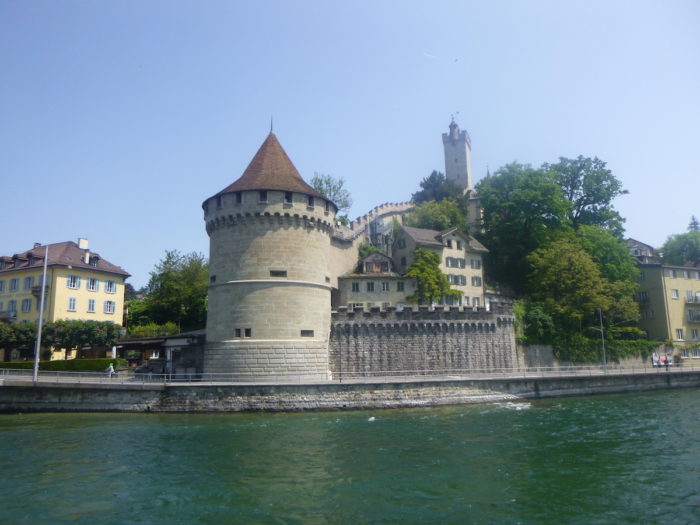 |
 |
| Luzern ranks in the top 50 most visited cities in the world, with over 1 million overnight stays recorded. It’s the most successful tourist destination in the Alpine region. In specific rankings for summer, Luzern is on top, just ahead of Interlaken, while Weggis takes 6th place. Salzburg is only 3rd in the ranking, but Austria dominates all podiums in winter, by far! In Luzern, Asian tourists, especially the Chinese before COVID, roam the city today. They come to visit a small country in the heart of Europe, much like the British did in their time, pioneers of tourism. But for them, it’s not for cheese and fresh air that they are here. Their interest lies in watches, knives, and jewelry. In fact, it was the Japanese who arrived first, especially in groups, to visit Luzern and ride the Luzern-Interlaken Express to go to Interlaken and purify their souls on the Jungfraujoch. These Asian tourists enjoyed stays in luxury hotels and favored branded products. Today, the Japanese market is stagnant, making way for the Chinese. But Koreans, Indians, and especially Gulf Arabs are emerging. Part of this horde of tourists takes the Luzern-Oberland Express to Interlaken. In Interlaken, some hotels have prayer rugs facing Mecca. Switzerland has somewhat sold its soul, one might say. You can take any bridge to get to the city center on the other side of the river. |
 |
 |

| There might be a little less crowd when it rains. But not sure! Jewelers, watchmakers, chocolate merchants, and trinket sellers are open regardless of the weather. |
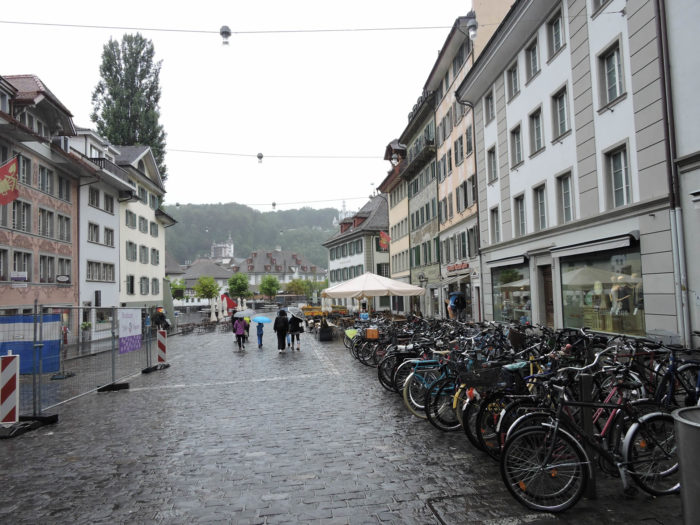 |
 |
| So, all these people, European, Asian, or from elsewhere in the world, parade through the cobbled streets and squares of the old town, in search of the best deal… …or simply to photograph the beautiful painted houses of the city. |
 |
 |
| Luzern is a city where history, culture, and commerce mingle, attracting visitors from around the world for its picturesque charm and lively atmosphere . |
 |
 |
Walking through the heart of the city allows you to grasp the invasive tourism in the city. Swan Square (Schwanenplatz) takes on the appearance of Chinatown or Hong Kong, minus the skyscrapers. The atmosphere there is frenetic. Organized tour buses drop off thousands of Asian visitors a little higher up, near Panorama Bourbaki. Yesterday mostly Chinese, today often Koreans and Indians as well. Employees in watch shops, where watches, knives, and jewelry are sold, have greatly adapted to Mandarin. In luxury shops, Chinese-speaking salespeople are often in the majority. Even pharmacists or cruise ship sailors are starting to chew on Mandarin. It must be said that for Asian travelers, the time spent in Luzern is often timed. The main occupation is choosing a watch or a knife, rather than visiting museums, churches, clothing or shoe shops. There’s little time left for strolling. So, they line up in front of cruise boats for short one-hour tours, which will allow them to immortalize Rigi or Pilatus on film.
Out of ten watches sold in Switzerland, four are sold in Luzern. The other major markets are Interlaken, Zurich, or Geneva. It’s mainly Asians, especially Chinese, who are fond of the merchandise. Estimates of daily expenses range from 400 to 2,000 Swiss francs in watch products, less taxed here than in Asia. Schwanenplatz is No.3 in the ranking of places where the most watches are sold in the world, behind Place Vendôme in Paris and Plazza 66 in Shanghai. No study precisely determines the amount of money spent by the Chinese in Europe or in Luzern. There aren’t only very wealthy people here, but it is estimated that some budgets hover around 30,000 francs, just for shopping. So, it’s better to almost sleep under the stars, to devote more money to good deals. Because if the Chinese spend their money on watches, they don’t all stay in palaces, often contenting themselves with much less prestigious hotels, at prices slashed by tour operators. Just go at closing time for the shops, and you’ll see hordes of Asians returning to their buses and going somewhere.
But who really stops, apart from Asians at Schwanenplatz, Swan Square? Not all watch shops are here. There are probably around a hundred watch shops in Luzern measuring time. But the most famous brands are all there, from 500-1,000 CHF to prices never displayed in stores. We can’t resist showing you an image from the internet, where forced sales, perhaps to clear stocks, were organized in the square.

| If you’re already stocked up on watches, then you have another Swiss tourism icon: the multifunctional Swiss army knife, which may one day also include the cell phone. Victorinox is the leader, almost a monopoly. The factory is just a stone’s throw away, between Schwyz and Brunnen, at the other end of the lake. You’ve passed by there.
We almost forgot about chocolate. Anyway! So tourists fill their bags with chocolate or läckerli, originating from Basel, close to gingerbread, with honey, candied fruits, and almonds. Others will prefer copies of Luxemburgerli, macarons, crunchy on the outside, filled with cream. Originally, these petits fours were the exclusivity of the confectioner Sprüngli, created by a Swiss-Luxembourgish pastry chef in Zurich in the fifties. The recipe is secret, and the petits fours are available in eight flavors, from mocha to amaretto or kirsch. Here in Luzern, they’re just copies. |
 |
 |
| Here, there are still a few watches to buy. |
 |
 |
| There’s still a must-visit in the city: the Lion of Luzern. As you climb towards the Lion of Luzern, you will pass by Panorama Bourbaki, a large rotunda over 40 meters in diameter, covered with paintings, dedicated to showing the misery of wounded, hungry, and freezing soldiers who crossed the Swiss border in 1871. The defeated French army, led by Bourbaki, was taken in by the Red Cross and Swiss authorities. This humanitarian work was created in 1881 by Edouard Castre, a Red Cross volunteer during the war.
It’s often crowded here, for a lion bored on its rock. So tourists sip a drink on the terrace, and the tourist train brings others. |
 |
 |
| Just above Panorama Bourbaki, The Lion of Luzern (Löwendenkmal), fatally wounded, doesn’t roar but attracts over a million people every year. The monument, erected in 1821, commemorates the massacre of Swiss mercenaries who fell in the service of the King of France in 1792, at the Tuileries Palace in Paris, during the French Revolution. The monument bears an inscription: Helvetiorum Fidei ac Virtuti (To the loyalty and bravery of the Swiss). |
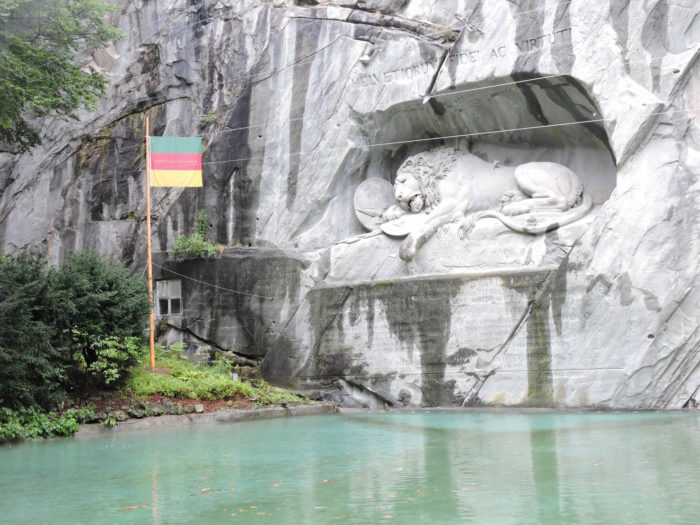 |
 |
| We’ve reached the end of the tour, and to complete the loop, we’re heading back to the train station. |
 |
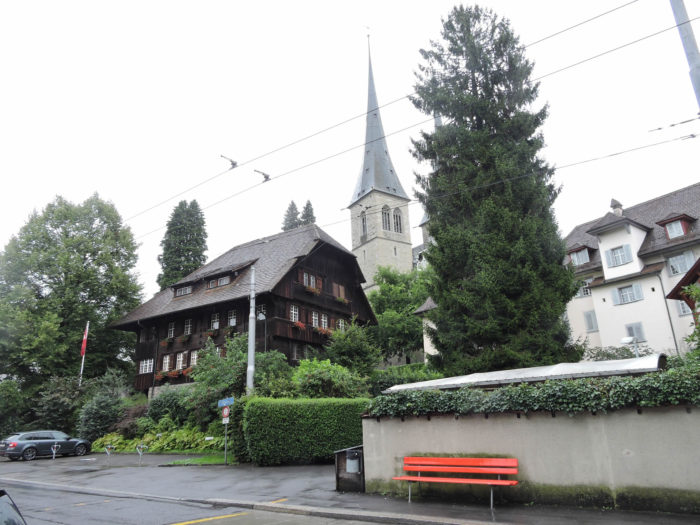 |
Along the way, St Leodegar Church (Leodegar im Hof) is the most important church in the Catholic canton of Luzern. Here, in the 7th century, there was a church dedicated to St. Maurice, a gift from Pepin the Short. Became Benedictine, the abbey was then dedicated to St. Leodegar, the city’s patron saint. The church was destroyed by fire and rebuilt in the late 19th century.

| Let’s go back to the lakeside. Tourists await cruise boats in the rain or in the sun. In the rain, tourists won’t see either Rigi or Pilatus. We must resign ourselves. This is the most popular travel attraction here in Luzern. Boats and buses take them there, to board further into cogwheel trains, which climb vertiginously to the top of the two mountains overlooking Luzern, one on each side. But the ducks and swans couldn’t care less about the weather. They beg, as usual. |
 |
 |
Feel free to add comments. This is often how you move up the Google hierarchy, and how more pilgrims will have access to the site.
|
 |
Next stage : Stage 10a: From Luzern to Werthenstein via Via Jacobi 3 |
|
 |
Back to menu |




























